Photographer Finds Ultra Rare Stieglitz Prints Hiding at Estate Sale
![]()
In December 2021, photographer Jeff Sedlik bid on an old, faded, framed print at an estate sale in Old Saybrook, Connecticut. Upon receiving it, he immediately opened the frame to examine the photo. To his amazement and delight, two identical prints were inside, and both turned out to be extremely rare classic platinum prints by Alfred Stieglitz.
“When I stumbled onto the estate sale, I paged through it, looking for photographs, and finding none,” says Sedlik, who teaches photography courses at the Art Center College of Design in Pasadena, California. “Then I spotted a framed photograph and immediately recognized it as an image that I reference in my lectures on the history of photography.
“I use this image and others created by Stieglitz during that period to illustrate the extent to which photographers liberally ‘borrowed’ from the work of painters during the formative period of pictorialism in photography. It is ironic, given that in attempting to establish photography as an independent art form, photographers sought to make their works appear more painterly and closely emulated scenes created by painters.
“I knew that this was one of at least two different photographs of women drawing water from wells, created by Stieglitz in Venice during his failed honeymoon (his wife was none too happy that he spent their honeymoon making images).
“I knew that there are no prints of this image in any public or private collection other than prints held at the National Gallery and that those prints are cropped differently than the print that Stieglitz chose to exhibit to the public. I knew Stieglitz routinely destroyed his negatives and prints to force himself to move forward artistically.
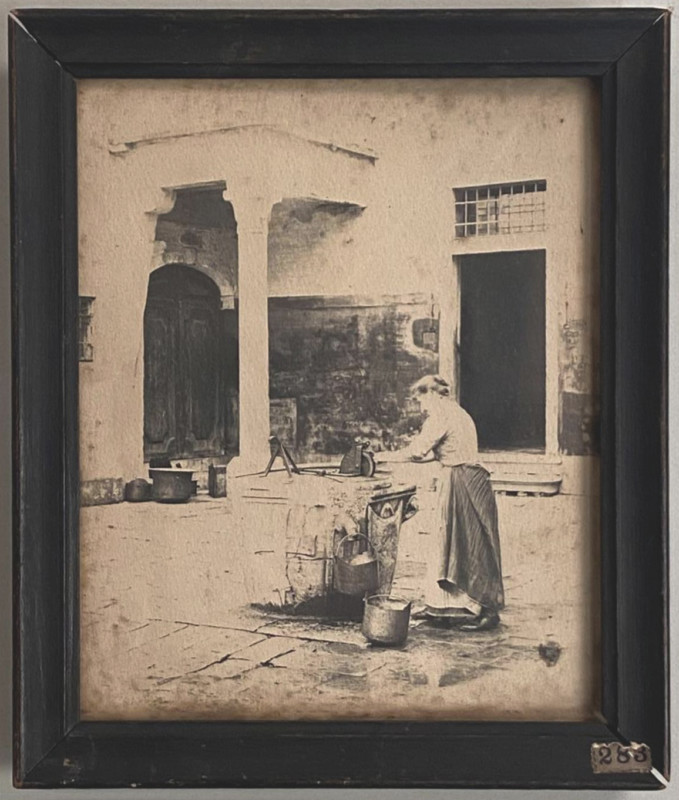
“I knew that his negatives from his honeymoon had been stored under the sink in his office at the New York Camera Club and that leaking water had destroyed all or nearly all of those negatives. Yes, I knew what I had found.
“I love the history of the Stieglitz photograph and the story behind it – the only known platinum print of this photograph ever exhibited by Stieglitz, and the fact that this image was among a handful of photographs that established Stieglitz as the leader of the movement to elevate the perception of photography as an art form.”
Rolling the Dice by Winning the Auction
“I was unable to inspect the print [before the auction] personally, and the seller had not removed the print from the frame for inspection,” remembers Sedlik. “I recognized that the print could be a reproduction.
“I was concerned the item might be a photogravure, but from the limited information available to me by inspecting the photograph of the framed print, it did not appear that the image had any of the hallmarks of a photogravure, such as a differential gloss in the shadows, surface relief, or ink resting above the paper.
“It was not possible to make a conclusive determination from an online photograph. But based on my experience, the odds were in my favor, and the opportunity justified the risk.
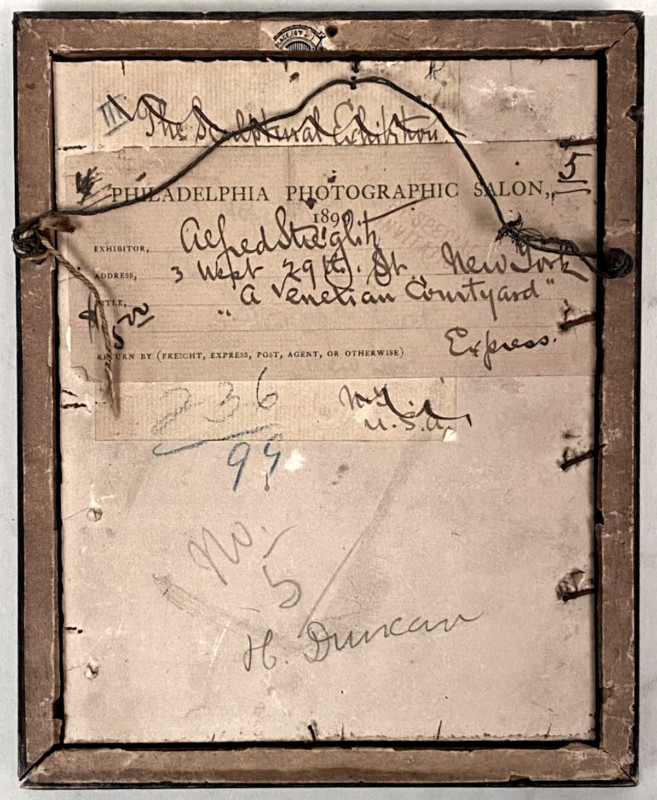
The name of Alfred Stieglitz and The Philadelphia Photographic Salon 1899 label with the office address at the Camera Club of New York was attached to the back of the frame. This did not raise any flags as this estate sale was not a photography sale – the items were mostly furniture and decorative items. Few, if any, collectors or gallerists would waste time on such a sale. Also, the auction house misspelled Stieglitz’s name and misspelled Philadelphia. Nobody was interested in this item except for Sedlik and one other bidder.
A bid of $2,200 (upped by $100 from the last bid) resulted in the only other bidder dropping out, and A Venetian Courtyard entered Sedlik’s collection. The estate sale auction house, Schwenke Auctioneers, did not inspect the print out of the frame and estimated the value at $100 to $200. Bidding started at $25.
An Unexpected Discovery
On receipt of the framed print, all of Sedlik’s fears were put to rest. He found that the faded print appeared to be a platinum print and had none of the hallmarks of a photogravure or other reproduction.
To his great surprise, on carefully removing the faded print from the frame, he discovered a second platinum print, hidden by Stieglitz, sandwiched between the front image and the backing board. The hidden print is in perfect condition and has the deep, rich tones and subtle tonal transitions expected in a platinum print.
Stieglitz was known to mount spare prints of his photographs to the back of his framed prints, to stiffen the framed print.
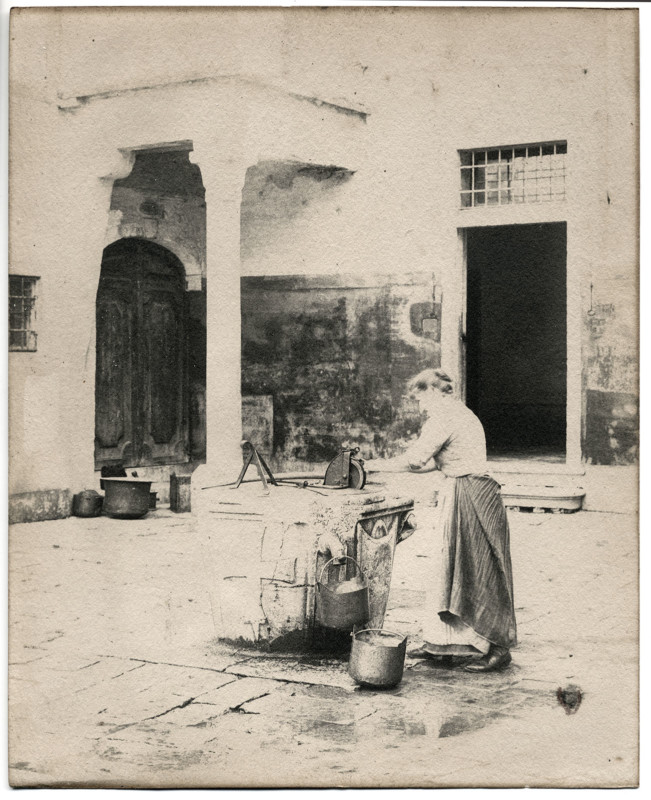
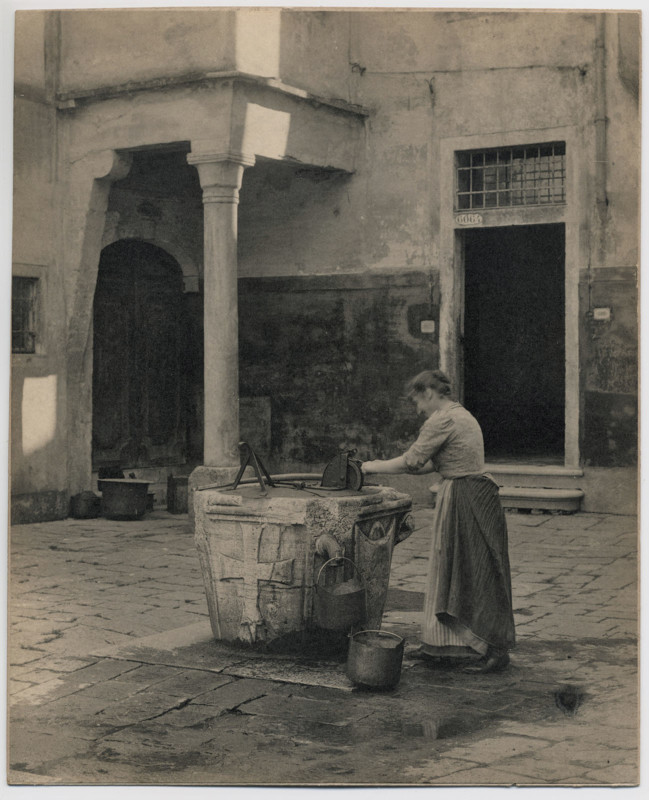
Sedlik examined the top print through the glass of the frame to ensure that there was no emulsion stuck to the glass. He then documented the positions of Stieglitz’s nails on the back of the frame and, wearing cotton gloves, carefully removed the back plate to examine the verso (back side) of the print for any inscriptions, markings, or mold.
“I examined the prints under magnification and confirmed the hallmarks of platinum printing are present – a matt surface sheen, long tonal range in the mid-tones, surface texture, and the image resting within the fibers,” says Sedlik. “In addition, a reversed, ghosted image appears on the verso of the front print, which occurs when a platinum print oxidizes over time, transferring a copy of the image to any paper in contact with the front of the print.”
Examining the Print
The platinum print at the front (viewable through the frame’s glass), unmounted, 7 x 5 ¾ in., is likely the print exhibited twice by Stieglitz in 1899. The yellowing may result from toning with mercury salts, as the print does not appear coated with wax or shellac, which are the common causes of yellowing.
While platinum prints are not typically susceptible to fading due to sun exposure, fading may occur due to issues with the sensitized paper or errors/shortcuts in print processing.
“I have consulted with leading platinum print conservation experts and am told that the fading on the front print was not caused by exposure to sunlight,” explains the photographer collector. “But was instead caused by an error in Stieglitz’s use of mercury salts in the sensitizer or developer.”
Stieglitz and other platinum printers used mercury to add a warm, sepia tone to their platinum prints. The print has likely been stable for over a century and is unlikely to continue to fade. The bottom, hidden photo is in perfect condition. This can be explained by Stieglitz’s correct use of mercury in the development of this print and is not related to the relative amount of UV exposure received by the two prints, Sedlik assures from his consultations with the experts.
Both the prints are on thin paper, which may explain why he chose to double the prints to stiffen them up so they would lay flat.
The verso of the front print includes a reversed, ghosted image of “A Venetian Courtyard,” caused by oxidization from the second platinum print hidden directly behind it.
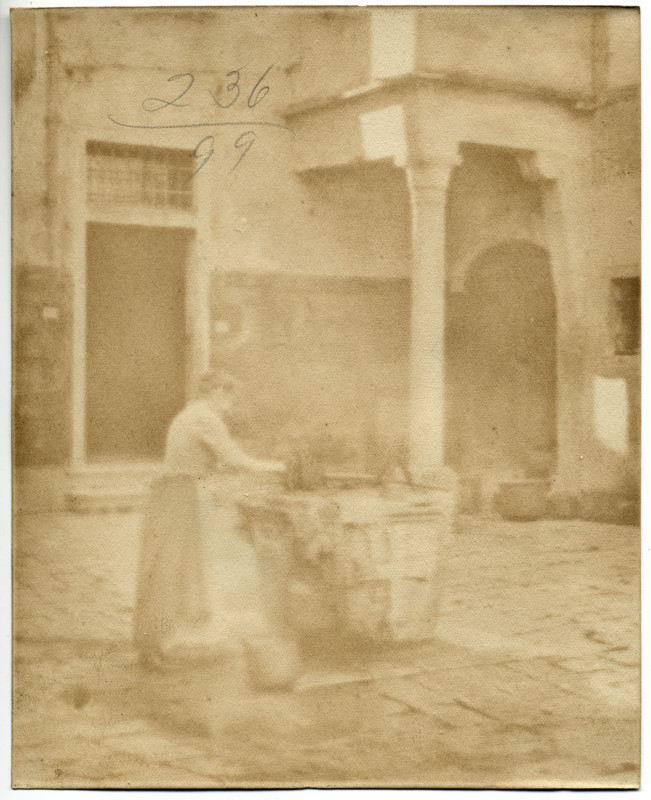
The hidden print is a platinum print, mounted, sheet trimmed to image, 7 x 5 ¾ in., has deep, rich tones, and is in perfect condition, with no fading or yellowing. An inscription of the verso of the hidden print indicates “Stieglitz” handwritten in script, likely by Stieglitz’s framer, George F. Of, whose label is also seen adhered to the frame verso.
The back plate of the framed Old Saybrook Print/s, 7 x 5 ¾ in., includes an 1899 Philadelphia Salon entry form handwritten by Stieglitz, with his 29th street office address (the Camera Notes address at the Camera Club), a title of “A Venetian Courtyard,” a price of $15. The January 1899 Journal of the PSP reports, “Forty-two pictures were sold during the exhibition at a total price of $482, the average being $11.95 each.” 1
The name “H. Duncan” is inscribed, likely indicating the attendee who purchased the print at the Salon.
The frame of the Old Saybrook Print/s 8 1/8 x 6 7/8 in., includes a decal at the bottom right corner, with the number “283,” matching the entry number assigned by the Philadelphia Salon to the Old Saybrook Print/s in 1899. This same number decal, adhered to the Old Saybrook Print/s, appears in a photograph of the Old Saybrook Print/s as exhibited with other Stieglitz photographs at the 1899 Philadelphia Salon.
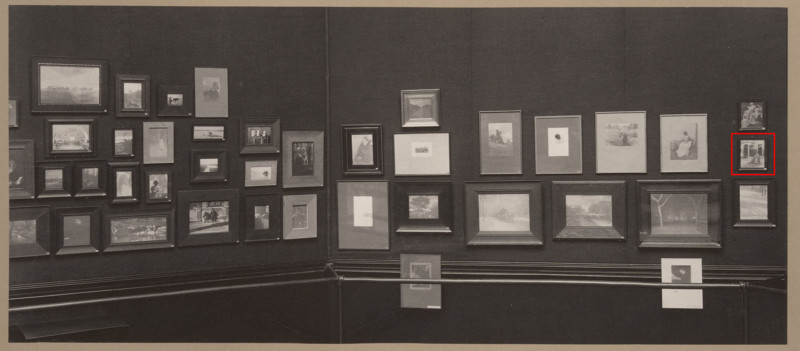
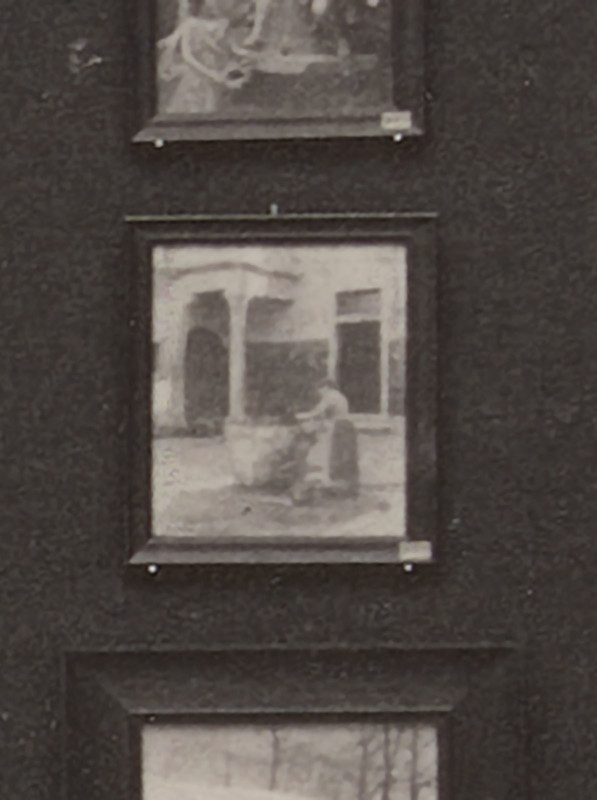
A copy of the The Philadelphia Photographic Salon 1899 catalog confirms that the print was #283 at the show.
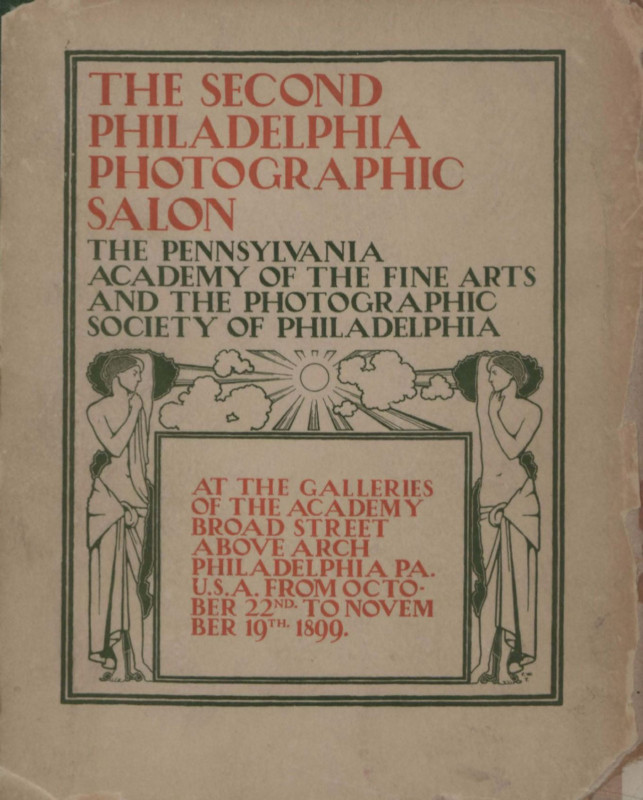
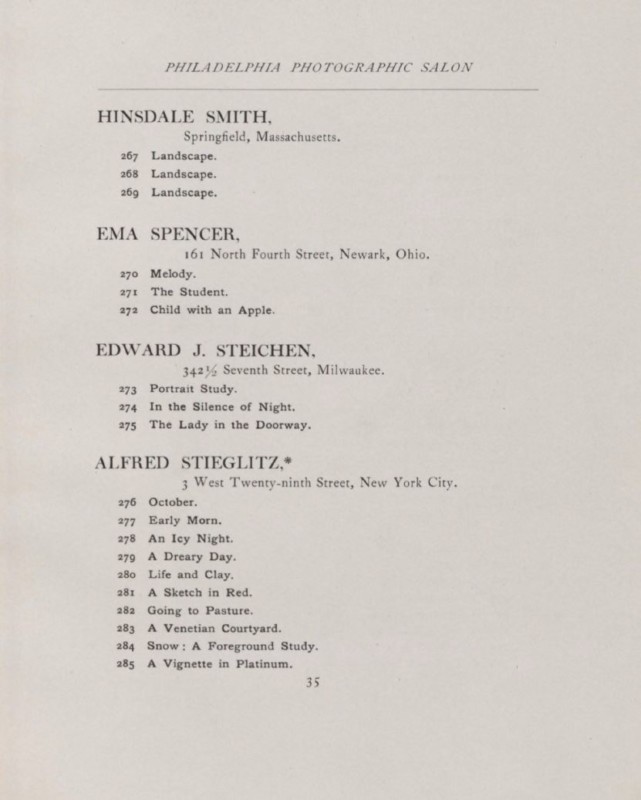
A label remnant adhered to the frame verso is the label of George F. Of, the famed framer who framed the work of Stieglitz, O’Keefe, Marin, and many others in Stieglitz’s circle.
![]()
The Stieglitz Key Set identifies three titles for the photograph: “A Venetian Courtyard,” “A Venetian Well,” and “A Well, Venice.” Notably, two known versions of “A Venetian Courtyard” are printed from the same negative. In one version, a woman appears in a window at the top right corner of the image.
In the Old Saybrook Print/s, Stieglitz cropped the image to eliminate the woman in the background, simplify the composition and focus attention on the woman and the well in the mid-ground. Before the discovery of the Old Saybrook Print/s, there was only one known print of a cropped version of this photograph. It is a different crop than the Old Saybrook Prints, which Stieglitz cropped for public exhibition.
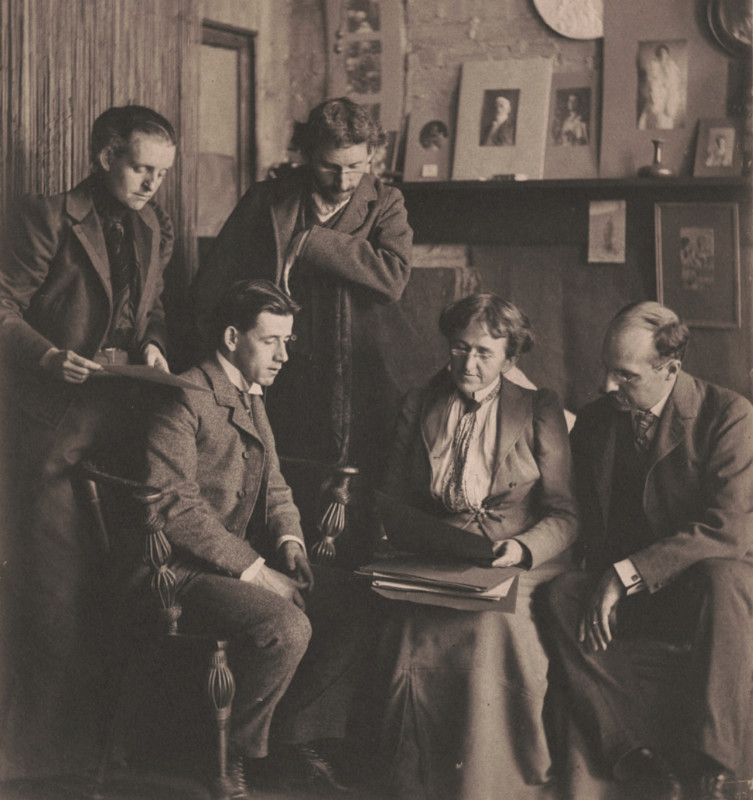
A Venetian Courtyard
Stieglitz made this photograph in 1894 on his European honeymoon with his first wife, Emmeline Obermeyer, in Campiello Santa Marina, Venice, just as “hand cameras” (handheld cameras) were gaining in popularity.
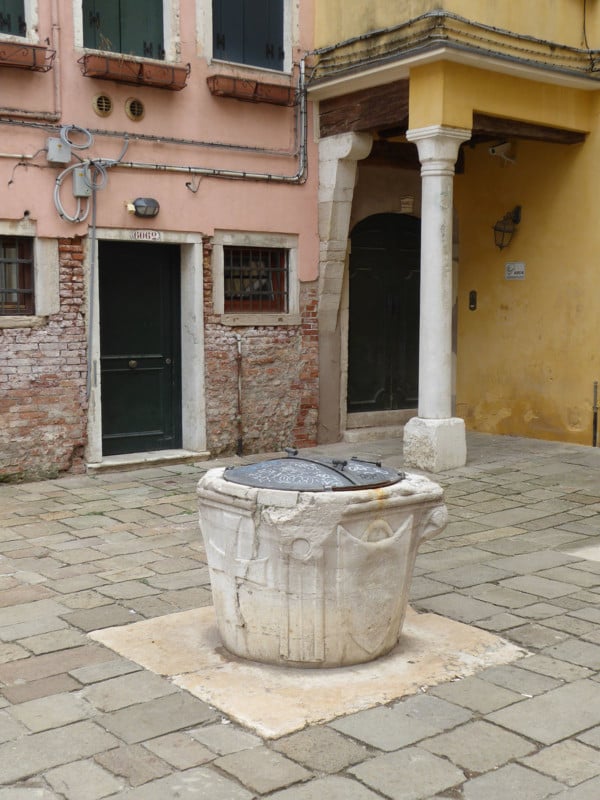
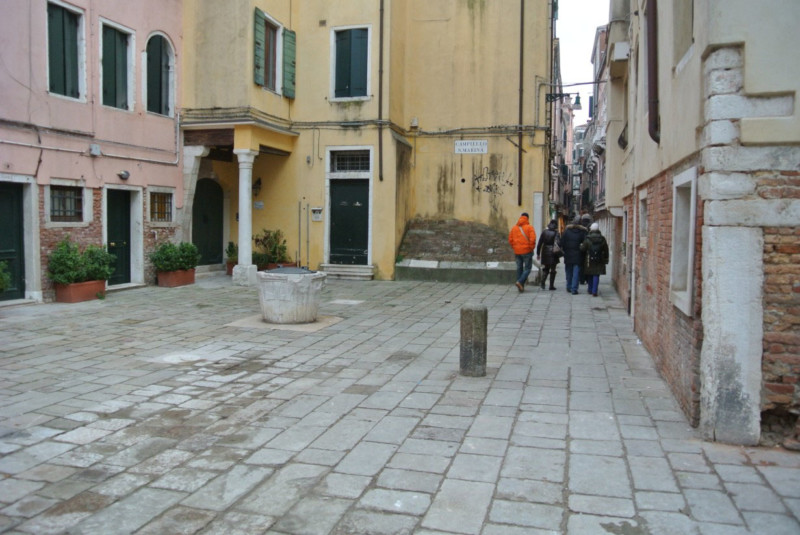
In 1892 Stieglitz bought his first handheld camera, a Folmer & Schwing 4×5 plate camera. Stieglitz was an advocate of the new handheld cameras, which allowed for increased spontaneity and creativity.
The negative was probably a 4×5 inch, and Stieglitz likely made an internegative from which the platinum was made by contact printing.
As he had done with Winter, Fifth Avenue, he made enlarged internegatives that allowed him to retouch his negatives more easily, remove distracting elements such as the anchor-line in Gossip—Katwyk, and make prints as big as fifteen, even occasionally twenty-one inches wide (Key Set numbers 208, 212, and 225). From these enlarged internegatives, he made carbon, gum bichromate, and photogravure prints, processes that allowed him to use the materials and palettes of a painter: he frequently printed these photographs on chine collé or thick, textured watercolor sheets in charcoal gray and brown, and even red, green, blue, and yellow on occasion. — The Key Set: 1884–1901, National Gallery of Art [emphasis ours]
The Key Set referenced above consists of at least one print of every mounted photograph in his possession at the time of his death and was selected by his wife, Georgia O’Keeffe
It is believed that Stieglitz first exhibited A Venetian Courtyard in May 1899 in the “Exhibition of Photographs by Alfred Stieglitz” at the Gallery of the Camera Club of New York. Stieglitz next exhibited the photograph in October 1899 in salon room #5 at “The Second Photographic Salon” of the Photographic Society of Philadelphia.
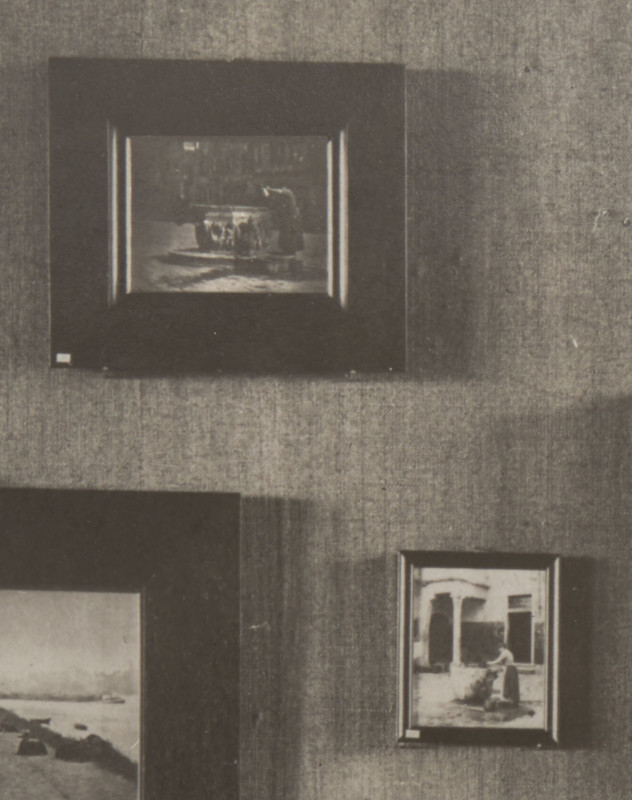
Stieglitz’s framed print may have been purchased by an attendee “H. Duncan” (whose name appears on the backplate beneath the salon label) for $15 (the asking price written on the salon label by Stieglitz and over $500 in today’s dollars when adjusted for inflation) at the Philadelphia Salon and remained in a private collection for 122 years until it resurfaced in a December 2021 auction of furniture, lamps, and decorative items in an Old Saybrook, Connecticut estate sale.
The genre scenes Stieglitz was interested in capturing in Venice were often in the center of a piazza. These piazze usually had a well that served as a water supply for the citizens of Venice. …. The location can be identified as the Campiello Santa Marina. In the center of the image is a hexagonal well with large, cross-shaped reliefs on each side. On the right-hand side of the image, a woman is busy turning the crank of a tackle, apparently to draw water from the well’s bottom. The woman is visible only in profile, with her arms extended forward to operate the crank. The slight blurring of her head lends her the very authentic appearance of a woman at work. She has her hair bound up in a bun and is wearing plain, functional clothing with a dark apron. In accordance with the title of the picture, Stieglitz did not focus on the individuality of the woman, who cannot be clearly recognized. His emphasis was on the well, which he put in sharp focus in the center of the image. – Page 116, Chiara Maria Pia Seidl’s 2020 Ph.D. thesis Collaboration and Innovation: Alfred Stieglitz and His European Heritage
Who Was Alfred Stieglitz?
Alfred Stieglitz (1864-1946) was an American photographer who helped popularize photography as an art form over his five decades of work. He was an important leader in the Pictorialist movement.
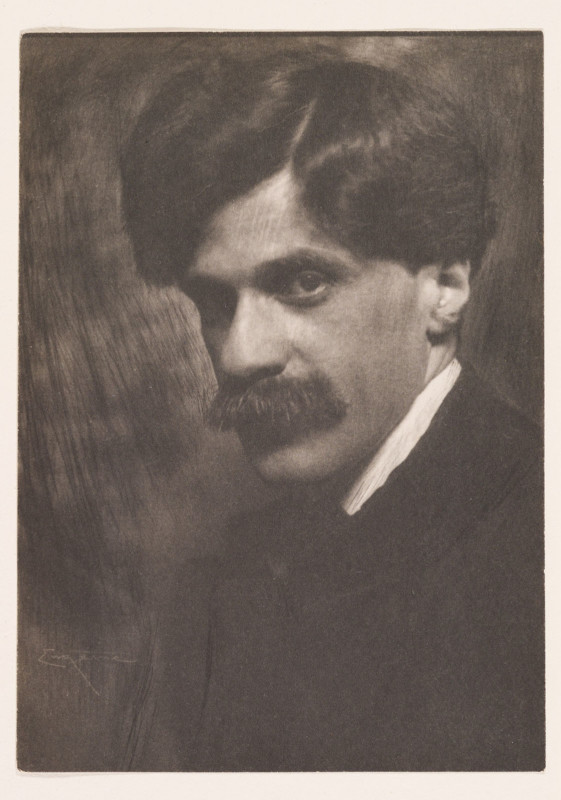
“Few individuals have exerted as strong an influence on 20th-century American art and culture as the photographer and art dealer Alfred Stieglitz,” says the National Gallery of Art.
Stieglitz was also fascinated by paintings. He operated a few New York Galleries in his lifetime. He introduced European painters to the US through them, organizing the first exhibitions in America of work by Pablo Picasso, Henri Matisse, Georges Braque, and Paul Cézanne, among others.
He made several hundred photographs of painter Georgia O’Keeffe – whom he married in 1924 — between 1917 and 1937. His refusal to encapsulate her personality into a single image was consistent with several modernist ideas.

Stieglitz prints are extremely rare and incredibly valuable. A 1919 palladium print showing O’Keefe’s hands sold at auction in 2006 for $1,472,000. A 1914 print titled From the Back-Window sold at a Christie’s auction in 2013 for $363,750, and another 1915 print titled sold in 2015 for $473,000.
What is a Platinum Print?
Platinum printing (and later palladium as platinum use was diverted to the military during WWI and shot up in price) was patented in the mid-1870s. It has a soft look as the emulsion does not sit on top of the paper, and there is no gelatin coating. The emulsion will soak into the paper allowing the metals to remain in place when the unexposed emulsion is washed away.
Platinum prints (aka platinotypes) are made using a mixture of iron and platinum salts. The paper is sensitized so that the image forms within the fibers. When properly processed, platinum prints do not degrade – or the paper will typically deteriorate before the image fades.
A platinum print has a larger tonal range compared to a silver print. The prints are also matt and have fewer reflections than silver prints, which also tended to curl due to the use of a gelatin coating.
Alfred Stieglitz’s choice process from the late 1880s to the early 1920s was the platinum print, or “platinotype.” He was an early adopter and appreciated the aesthetic properties and permanence.
Stieglitz liked the matte surface of platinum papers and the rich range of tones. He wrote eighteen articles between 1887 to 1902 in which he wrote reviews of commercial papers and products. He also wrote techniques of hand-sensitizing papers and chemical manipulations, which could alter the image’s tone from neutral grey to sepia. And it is probably one of these manipulations that resulted in the top print’s fading rather than its exposure to UV or light over the last 122 years.
Sedlik: Photographer, Teacher, Collector, Copyright Expert
Sedlik’s father was a military photographer, inspiring him to pursue photography. He presented Sedlik with his first camera at age eight. At age 12, Sedlik built a darkroom in his bedroom closet, making portraits of his friends and family, and shooting for the school paper and yearbook. He went on to study photography and business at the University of California at Santa Barbara, then earned his BFA degree in an intensive professional photography program at the Art Center College of Design in Pasadena, California.
While studying at the Art Center, he learned about the business side of photography and the importance of copyright. He was elected as the national president of the Advertising Photographers of America (now American Photographic Artists). As president, he worked closely with the copyright office and legislators on copyright reforms.
Sedlik has invested the earnings from the sale of his own fine art prints of musicians, monks, matadors, and others to purchase works by Cartier-Bresson, Karsh, Bravo, Penn, Lange, Bullock, Sander, Weston, Cunningham, Kertész, Iturbide, Bernhard, Rothstein, Emerson, Tress, Boubat, Curtis, Ronis, Lessing, and more.
Over the years, he has developed deep knowledge and expertise in copyright law related to the visual arts. Both the House and Senate have repeatedly summoned him to testify before their Judiciary Committees on copyright reform. In addition to teaching copyright law and licensing at the Art Center College for 25 years, he is frequently hired by law firms to provide litigation strategy consulting and expert witness testimony.
The Future of the Found Stieglitz Prints
The Stieglitz prints have been stored in a secure, climate-controlled facility for safekeeping and to ensure that these historically important prints are preserved.
“After my discussions with conservators to verify the platinum prints and to determine if any action is needed to preserve them (none is), word spread in the cultural heritage and photography communities, and various gallerists, museums, and collectors have contacted me,” says the photographer.
But Sedlik is in no hurry.
“I have not had the prints appraised, as I am not actively offering the prints for sale,” says Sedlik. “Their unique history and verifiable exhibition add to their value. I will need to seek an appraisal for insurance purposes.”
1 Clare Fleming et al. “Newly Revealed: Photographic Society of Philadelphia Records and Inventory of the Philadelphia Photographic Salon Albums (1898-1901).” U. Rochester and G. Eastman House 2015. http://hdl.handle.net/1802/33134
About the author: Phil Mistry is a photographer and teacher based in Atlanta, GA. He started one of the first digital camera classes in New York City at The International Center of Photography in the 90s. He was the director and teacher for Sony/Popular Photography magazine’s Digital Days Workshops. You can reach him here.
Image credits: Header photos of Venetian Courtyard by Alfred Stieglitz, left is top faded photo and right is bottom unfaded photo, courtesy Jeff Sedlik.